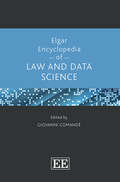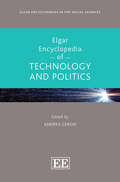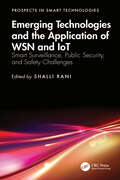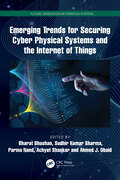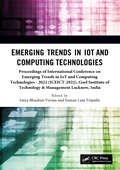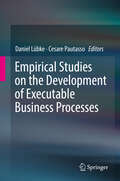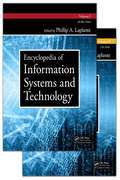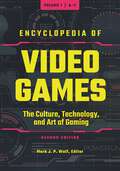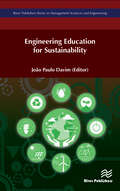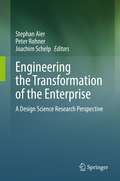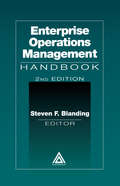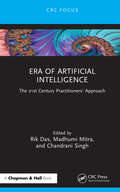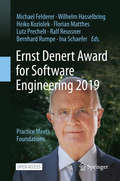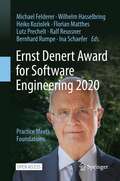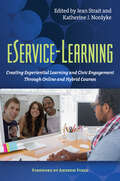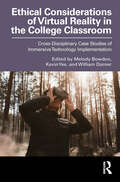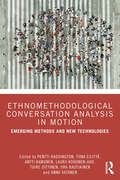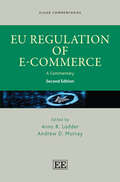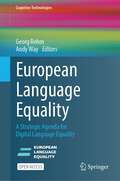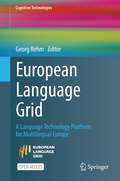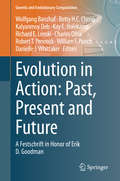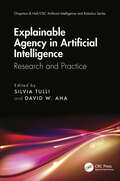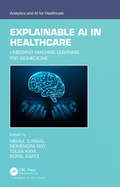- Table View
- List View
Elgar Encyclopedia of Law and Data Science
The Elgar Encyclopedia of Law and Data Science represents a comprehensive mapping of the field. Comprising over 60 entries, it features contributions from eminent global scholars, drawing on expertise from multiple disciplines, including law and data science, economics, computer engineering, physics, biomedical engineering and history, philosophy, neuro-engineering, political science, and geo-informatics.This Encyclopedia brings together jurists, computer scientists, and data analysts to uncover the challenges, opportunities, and fault lines that arise as these groups are increasingly thrown together by expanding attempts to regulate and adapt to a data-driven world. It explains the concepts and tools at the crossroads of the many disciplines involved in data science and law, bridging scientific and applied domains. Entries span algorithmic fairness, consent, data protection, ethics, healthcare, machine learning, patents, surveillance, transparency and vulnerability.Comprehensive yet accessible, this Encyclopedia will be an indispensable resource for scholars of law, data science, artificial intelligence and law and technology. It also contains practical implications for a manifold of users: from domain experts to policy makers, from businesses to practitioners.Key Features:P>The first Encyclopedic coverage of the field of Law and Data ScienceOver 60 entriesEntries organized alphabetically for ease of referenceFull analytical indexInterrelated multidisciplinary perspectivesUnique accessibility for non-experts.
Elgar Encyclopedia of Technology and Politics (Elgar Encyclopedias in the Social Sciences series)
The Elgar Encyclopedia of Technology and Politics is a landmark resource that offers a comprehensive overview of the ways in which technological development is reshaping politics. Providing an unparalleled starting point for research, it addresses all the major contemporary aspects of the field.Divided into five thematic parts, the Encyclopedia investigates the existing academic literature on the main subfields in this area, before introducing innovative digital research methods. It then highlights the pivotal political and non-political actors leading the process of technological innovation, clarifies key concepts and terms in the field, and finally covers emerging and debated topics.This Encyclopedia will be particularly invaluable for early career researchers and advanced students in politics looking for a concise entry point into any of the various ways in which technology shapes the field. It will also be useful for practitioners to familiarise themselves with the analytical opportunities provided by computational social and political sciences.Key Features:Entries written by over 90 scholars from 33 different countries on 5 continentsAccessible starting point for research into the key literature, topics and debates in the fieldIntroduces important new digital methods such as machine learning, text analysis and network analysisDefines and clarifies the meaning of contested terms such as disinformation, echo chambers and fake news
Emerging Technologies and the Application of WSN and IoT: Smart Surveillance, Public Security, and Safety Challenges (Prospects in Smart Technologies)
The Internet of Things (IoT) has numerous applications, including smart cities, industries, cloud-based apps, smart homes, and surveillance.The Internet of Things (IoT) enables smarter living by connecting devices, people, and objects. As networking became a crucial aspect of the Internet, rigorous design analysis led to the development of new research areas.The Internet of Things has revolutionized daily living in countless ways. It enables communication between buildings, people, portable gadgets, and vehicles, facilitating mobility. Smart cities and cloud-based data have transformed corporate practices. With billions of connected gadgets, everything will soon be able to communicate remotely. IoT networks, whether public or private, rely significantly on machine learning and software-defined networking. Indian and other governments have approved various research projects on IoT-based networking technologies. This field of study will significantly impact society in the future.Researchers are concerned about the many application areas and driving forces behind smart cities. The authors aim to provide insights into software-defined networking, artificial intelligence, and machine learning technologies used in IoT and networking. The framework focuses on practical applications and infrastructures. The book includes practical challenges, case studies, innovative concepts, and other factors that impact the development of realistic scenarios for smart surveillance. It also highlights innovative technology, designs, and algorithms that can accelerate the creation of smart city concepts.This resource includes real-world applications and case studies for smart city technology, enormous data management, and machine learning prediction, all with confidentiality and safety problems.
Emerging Trends for Securing Cyber Physical Systems and the Internet of Things (Future Generation Information Systems)
In the past decades, cyber-physical systems (CPSs) have been widely applied to fields such as smart grids, environment monitoring, aerospace, smart transportation, and industrial automation. Great strides have been made in CPSs to improve the computing mechanism, communication, and quality of service by applying optimization algorithms. Currently, these efforts are integrated with the applications of machine learning (ML) and artificial intelligence (AI). To maintain system reliability and stability, CPSs such as smart grids face numerous challenges, including large-scale Internet-of-Things (IoT) device adaptation, ever-increasing demands of electrical energy, and the rise of a wide range of security threats. These challenges bring forth the need to find sustainable and advanced solutions to guarantee reliable and secure operations in these systems.The goal of this book is to foster transformative, multidisciplinary, and novel approaches that ensure CPS security by taking into consideration the unique security challenges present in the environment. This book attracts contributions in all aspects pertaining to this multidisciplinary paradigm, which includes the development and implementation of Smart CPS, Supervisory Control and Data Acquisition (SCADA) systems, CPS for Industry 4.0, CPS architecture for IoT applications, and CPS forensics.This book: Discusses concepts including wireless sensor networks (WSNs), CPSs, and the IoT in a comprehensive manner. Covers routing protocols in sensor networks, attacks, and vulnerabilities in WSNs, the Internet of Cyber-Physical Things, and CPSs for industrial applications. Highlights technological advances, practical solutions, emerging trends, and prototypes related to privacy in CPSs and the IoT. Presents a pathway and architecture for proactive security schemes in CPSs to counter vulnerabilities, including phishing attacks, malware injection, internal stealing of data, and hacking. Discusses the most recent research and development on the enabling technologies for IoT-based CPSs. Owing to the scope and diversity of topics covered, the book will be of interest not only to researchers and theorists but also to professionals, material developers, technology specialists, and methodologists dealing with the multifarious aspects of data privacy and security enhancement in CPSs. The book will provide these professionals an overview of CPS security and privacy design, as well as enlighten them to promising solutions to research problems such as cyberattacks in CPS, risk identification and management in CPS, ML-based trust computational models for CPSs, nature-inspired algorithms for CPSs, and distributed consensus algorithms for event detection in CPSs. The secondary target audience of this book includes legal practitioners, hackers, cyber law policymakers, cyber forensic analysts, and global security consortiums who may use it to further their research exposure to pertinent topics in cybersecurity.
Emerging Trends in IoT and Computing Technologies: Proceedings of the International Conference on Emerging Trends in IoT and Computing Technologies (ICEICT-2022), April 22-23, 2022, Lucknow, India
This book includes the proceedings of the International Conference on Emerging Trends in IoT and Computing Technologies (ICEICT-2022) held at Goel Institute of Technology & Management, Lucknow, India.
Empirical Studies on the Development of Executable Business Processes
This book collects essential research on the practical application of executable business process modeling in real-world projects, i.e., model-driven solutions for the support and automation of digital business processes that are created using languages such as BPEL or BPMN. It mainly focuses on empirical research, but also includes an up-to-date cross-section of case studies in order to assess examples of BPM’s practical impact in the industry.On the one hand, executable models are formally and precisely defined so that computers can interpret and execute them; on the other, they are visualized so that humans can describe, document and optimize business processes at a higher level of abstraction than with traditional textual programming languages. While these important research areas have long been separated from one another, this book is an attempt at cross-fertilization, driven by the insight that business processes are the software behind today’s digital organizations, and that achieving a precise representation of such processes is key to their reliable execution. Consequently, the book presents various case studies and experiments that investigate questions of interest to both academia (e.g., identifying challenges for which no solution exists; sharing new insights into how existing approaches are actually used) and industry (e.g., guidelines on using certain technologies and on modeling comprehensible and executable processes).Both researchers and practitioners will benefit from the presentation of how concepts are transformed into working solutions. The studies are presented in a structured manner and with sufficient rigor to be considered empirical research, further enhancing the book’s value for the research community, while practitioners will find concrete guidance on making the right decisions for their projects.
Encyclopedia of Information Systems and Technology - Two Volume Set
Spanning the multi-disciplinary scope of information technology, the Encyclopedia of Information Systems and Technology draws together comprehensive coverage of the inter-related aspects of information systems and technology.The topics covered in this encyclopedia encompass internationally recognized bodies of knowledge, including those of The IT BOK, the Chartered Information Technology Professionals Program, the International IT Professional Practice Program (British Computer Society), the Core Body of Knowledge for IT Professionals (Australian Computer Society), the International Computer Driving License Foundation (European Computer Driving License Foundation), and the Guide to the Software Engineering Body of Knowledge. Using the universally recognized definitions of IT and information systems from these recognized bodies of knowledge, the encyclopedia brings together the information that students, practicing professionals, researchers, and academicians need to keep their knowledge up to date. Also Available OnlineThis Taylor & Francis encyclopedia is also available through online subscription, offering a variety of extra benefits for researchers, students, and librarians, including: Citation tracking and alerts Active reference linking Saved searches and marked lists HTML and PDF format options Contact Taylor and Francis for more information or to inquire about subscription options and print/online combination packages.US: (Tel) 1.888.318.2367; (E-mail) e-reference@taylorandfrancis.comInternational: (Tel) +44 (0) 20 7017 6062; (E-mail) online.sales@tandf.co.uk
Encyclopedia of Video Games [3 volumes]: The Culture, Technology, and Art of Gaming [3 volumes]
Now in its second edition, the Encyclopedia of Video Games: The Culture, Technology, and Art of Gaming is the definitive, go-to resource for anyone interested in the diverse and expanding video game industry.This three-volume encyclopedia covers all things video games, including the games themselves, the companies that make them, and the people who play them. Written by scholars who are exceptionally knowledgeable in the field of video game studies, it notes genres, institutions, important concepts, theoretical concerns, and more and is the most comprehensive encyclopedia of video games of its kind, covering video games throughout all periods of their existence and geographically around the world.This is the second edition of Encyclopedia of Video Games: The Culture, Technology, and Art of Gaming, originally published in 2012. All of the entries have been revised to accommodate changes in the industry, and an additional volume has been added to address the recent developments, advances, and changes that have occurred in this ever-evolving field. This set is a vital resource for scholars and video game aficionados alike.
Engineering Education for Sustainability
Understood to be a key issue in modern society, sustainability is characterized by its three essential pillars, namely: the environment, society and the economy. Education plays an important role in how people understand and accept sustainability. The integration of sustainability in engineering education is a relatively new phenomenon, and presenting information about engineering education for sustainability is of great interest to improve communication between professors, researchers and students at universities, institutes and research laboratories.Topics discussed in the book include: Experiences from 5 years of educating sustainability to computer science students Review of decision support methods in green and sustainable supply chains Analyzing the drivers of engineering education for sustainability using the MCDM approach Visualization technologies in construction education: a comprehensive review of recent advances A legal framework and compliance with construction safety laws and regulations
Engineering the Transformation of the Enterprise: A Design Science Research Perspective
The topics in this book cover a broad range of research interests: from business engineering and its application in corporate and business networking contexts to design science research as well as applied topics, where those research methods have been employed for modeling, data warehousing, information systems management, enterprise architecture management, management of large and complex projects, and enterprise transformation. The book is a Festschrift for Robert Winter in order to appreciate his work and to honor him as a personality with a high reputation in the information systems community. To this end, many professional colleagues or long-time companions both from the Institute of Information Management at the University of St. Gallen as well as from the international research community dedicated articles on topics related to Robert’s research. They reflect his ambition to uncompromisingly conduct high-class research that fuels the research community and at the same time contributes to improved industrial practice. The book is organized in three major parts: Part I “Business Engineering and Beyond” focuses on the methodology strongly shaped by Robert in St. Gallen with a focus on research being applied in corporate contexts. Part II “Design Science Research” spans from reflections on the practice of design science research to perspectives on design science research methodologies and eventually up to considerations to teach design science research methodology. Part III “Applied Fields” combines various applications of design science and related research methodologies with practical problems and future research topics.
Enterprise Operations Management Handbook, Second Edition
The Enterprise Operations Management Handbook provides the expert advice and guidance of hundreds of leading computing practitioners and consultants. Covering all major areas of enterprise operations management, this edition provides essential information for managing a modern, evolving data center. Topics include business issues, technology issues, and operational issues. This current, practical reference also reviews such critical areas as strategic planning, data center management, data center controls, systems planning, network technology, contingency planning, human resource planning, desktop computing, and future directions. The Enterprise Operations Management Handbook serves as an invaluable tool for designing, building, and maintaining a high-performance, service-oriented data center.
Era of Artificial Intelligence: The 21st Century Practitioners’ Approach
This text has attempted to collate quality research articles ranging from A Mathematical Disposition for Neural Nets, to Cognitive Computing, to Quantum Machine Learning, to a Multimodal Emotion Recognition System, to Responsible AI, to AI for Accessibility and Inclusion, to Artificial-Enabled Intelligence Enabled Applications in the sectors of Health, Pharma and Education. Features Focus on AI research and interdisciplinary research that exhibits AI inclusion to a greater degree Focus on application of disruptive technology in the context of the twenty-first century human and machine approach Focus on role of disruptive technology such as cognitive computing, quantum machine learning, IOT enabled-recognition systems Focus on unravelling the powerful features of artificial intelligence for societal benefits including accessibility This volume will cater as a ready reference to an individual’s quest for deep diving into the ocean of artificial intelligence-enabled solution approaches. The book will serve as a useful reference for researchers, innovators, academicians, entrepreneurs, and professionals aspiring to gain expertise in the domain of cognitive and quantum computing, IOT-enabled intelligent systems and so on.
Ernst Denert Award for Software Engineering 2019: Practice Meets Foundations
This open access book provides an overview of the dissertations of the five nominees for the Ernst Denert Award for Software Engineering in 2019. The prize, kindly sponsored by the Gerlind & Ernst Denert Stiftung, is awarded for excellent work within the discipline of Software Engineering, which includes methods, tools and procedures for better and efficient development of high quality software. An essential requirement for the nominated work is its applicability and usability in industrial practice. The book contains five papers describing the works by Sebastian Baltes (U Trier) on Software Developers’Work Habits and Expertise, Timo Greifenberg’s thesis on Artefaktbasierte Analyse modellgetriebener Softwareentwicklungsprojekte, Marco Konersmann’s (U Duisburg-Essen) work on Explicitly Integrated Architecture, Marija Selakovic’s (TU Darmstadt) research about Actionable Program Analyses for Improving Software Performance, and Johannes Späth’s (Paderborn U) thesis on Synchronized Pushdown Systems for Pointer and Data-Flow Analysis – which actually won the award. The chapters describe key findings of the respective works, show their relevance and applicability to practice and industrial software engineering projects, and provide additional information and findings that have only been discovered afterwards, e.g. when applying the results in industry. This way, the book is not only interesting to other researchers, but also to industrial software professionals who would like to learn about the application of state-of-the-art methods in their daily work.
Ernst Denert Award for Software Engineering 2020: Practice Meets Foundations
This open access book provides an overview of the dissertations of the eleven nominees for the Ernst Denert Award for Software Engineering in 2020. The prize, kindly sponsored by the Gerlind & Ernst Denert Stiftung, is awarded for excellent work within the discipline of Software Engineering, which includes methods, tools and procedures for better and efficient development of high quality software. An essential requirement for the nominated work is its applicability and usability in industrial practice.The book contains eleven papers that describe the works by Jonathan Brachthäuser (EPFL Lausanne) entitled What You See Is What You Get: Practical Effect Handlers in Capability-Passing Style, Mojdeh Golagha’s (Fortiss, Munich) thesis How to Effectively Reduce Failure Analysis Time?, Nikolay Harutyunyan’s (FAU Erlangen-Nürnberg) work on Open Source Software Governance, Dominic Henze’s (TU Munich) research about Dynamically Scalable Fog Architectures, Anne Hess’s (Fraunhofer IESE, Kaiserslautern) work on Crossing Disciplinary Borders to Improve Requirements Communication, Istvan Koren’s (RWTH Aachen U) thesis DevOpsUse: A Community-Oriented Methodology for Societal Software Engineering, Yannic Noller’s (NU Singapore) work on Hybrid Differential Software Testing, Dominic Steinhofel’s (TU Darmstadt) thesis entitled Ever Change a Running System: Structured Software Reengineering Using Automatically Proven-Correct Transformation Rules, Peter Wägemann’s (FAU Erlangen-Nürnberg) work Static Worst-Case Analyses and Their Validation Techniques for Safety-Critical Systems, Michael von Wenckstern’s (RWTH Aachen U) research on Improving the Model-Based Systems Engineering Process, and Franz Zieris’s (FU Berlin) thesis on Understanding How Pair Programming Actually Works in Industry: Mechanisms, Patterns, and Dynamics – which actually won the award. The chapters describe key findings of the respective works, show their relevance and applicability to practice and industrial software engineering projects, and provide additional information and findings that have only been discovered afterwards, e.g. when applying the results in industry. This way, the book is not only interesting to other researchers, but also to industrial software professionals who would like to learn about the application of state-of-the-art methods in their daily work.
eService-Learning: Creating Experiential Learning and Civic Engagement Through Online and Hybrid Courses
This book serves as an introduction to using online teaching technologies and hybrid forms of teaching for experiential learning and civic engagement. Service-learning has kept pace neither with the rapid growth in e-learning in all its forms nor with the reality that an increasing number of students are learning online without exposure to the benefits of this powerful pedagogy.Eservice-learning (electronic service-learning) combines service-learning and on-line learning and enables the delivery of the instruction and/or the service to occur partially or fully online. Eservice-learning allows students anywhere, regardless of geography, physical constraints, work schedule, or other access limitations, to experience service-learning. It reciprocally also equips online learning with a powerful tool for engaging students.In eservice-learning, the core components of service, learning, and reflection may take a different form due to the online medium—for example, reflection often occurs through discussion board interactions, journals, wikis, or blogs in an eservice-learning course. Moreover, the service, though still community-based, creates a world of opportunities to connect students with communities across the globe—as well as at their very own doorstep.This book introduces the reader to the four emerging types of eservice-learning, from Extreme EService-Learning (XE-SL) classes where 100% of the instruction and 100% of the service occur online, to three distinct forms of hybrid where either the service or the instruction are delivered wholly on-line – with students, for instance, providing online products for far-away community partners – or in which both are delivered on-site and online. It considers the instructional potential of common mobile technologies – phones, tablets and mobile reading devices. The authors also address potential limitations, such as technology challenges, difficulties sustaining three-way communication among the instructor, community partner, and students, and added workload.The book includes research studies on effectiveness as well as examples of practice such drafting grants for a community partner, an informational technology class building online communities for an autism group, and an online education class providing virtual mentoring to at-risk students in New Orleans from across the country.
EA Sports FIFA: Feeling the Game
If there is anything close to a universal game, it is association football, also known as soccer, football, fussball, fútbol, fitba, and futebol. The game has now moved from the physical to the digital - EA's football simulation series FIFA - with profound impacts on the multibillion sports and digital game industries, their cultures and players. Throughout its development history, EA's FIFA has managed to adapt to and adopt almost all video game industry trends, becoming an assemblage of game types and technologies that is in itself a multi-faceted probe of the medium's culture, history, and technology. EA Sports FIFA: Feeling the Game is the first scholarly book to address the importance of EA's FIFA. From looking at the cultures of fandom to analyzing the technical elements of the sports simulation, and covering the complicated relations that EA's FIFA has with gender, embodiment, and masculinity, this collection provides a comprehensive understanding of a video game series that is changing the way the most popular sport in the world is experienced. In doing so, the book serves as a reference text for scholars in many disciplines, including game studies, sociology of sports, history of games, and sports research.
Ethical Considerations of Virtual Reality in the College Classroom: Cross-Disciplinary Case Studies of Immersive Technology Implementation
Ethical Considerations of Virtual Reality in the College Classroom collects case studies that address both pedagogical and ethical foundations of extended reality tools in postsecondary learning environments across disciplines. With today’s institutional programs and faculty leveraging cutting-edge virtual, augmented, and mixed reality opportunities to teach and promote achievement goals, it is imperative that new research into these technologies speaks directly to their challenges and affordances within broad academic settings. This book showcases real-world examples of faculty members who chronicle and develop their use of VR tools across learning contexts and student populations by creating their own digital experiences, adapting open-source tools, integrating commercial products, amplifying crucial course content, analyzing outcomes data, and more. Nontechnical readers will come away with a new understanding of key terms and concepts associated with virtual reality and essential heuristics for evaluating the ethical implications of immersive approaches.
Ethnomethodological Conversation Analysis in Motion: Emerging Methods and New Technologies
This volume discusses current and emerging trends in Ethnomethodological Conversation Analysis (EMCA). Focusing on step-by-step procedures of talk and interaction in real time, EMCA explores how people – through locally-produced, public, and common-sensical practices – accomplish activities together and thereby make sense and create social order as part of their everyday lives. The volume is divided into four parts, and it provides a timely methodological contribution by exploring new questions, settings, and recording technologies in EMCA for the study of social interaction. It addresses the methodical diversity in EMCA, including current practices as well as those testing its boundaries, and paves way for the development of future interaction research. At the same time, the book offers readers a glimpse into the ways in which human and non-human participants operate with each other and make sense of the world around them. The authors represent diverse fields of research, such as language studies, sociology, social psychology, human-computer interaction, and cognitive science. Ultimately, the book is a conversation opener that invites critical and constructive dialogue on how EMCA’s methodology and toolbox could be developed for the purpose of acquiring richer perspectives on endogenous social action. This is key reading for researchers and advanced students on a range of courses on conversation analysis, language in interaction, discourse studies, multimodality and more.
EU Regulation of E-Commerce: A Commentary (Elgar Commentaries series)
Significantly revised and expanded, this important book addresses the key pieces of EU legislation in the field of e-commerce, including on consumer rights, copyright, electronic identification, open internet access, electronic payments, competition law and digital content.Key features of this second edition include:thoroughly up-to-date analysis of decisions of the Court of Justice and the Commissionarticle-by-article commentary on the latest directives and regulations in the field of e-commercea unique structure featuring detailed tables of cases and legislation and paragraph references, enabling easy access to all substantive legal provisionsnew chapters featuring analysis of services in the internal market, copyright in the Digital Single market, measures concerning open internet access and more.This unique work provides an updated account of the essential pieces of EU legislation on e-commerce. Legal practitioners will benefit from the clear structure and close examination of key provisions. The book will also appeal to legal scholars and advanced students, who will appreciate the concise overview and thoughtful analysis on future developments in the field.
European Language Equality: A Strategic Agenda for Digital Language Equality (Cognitive Technologies)
This open access book presents a comprehensive collection of the European Language Equality (ELE) project’s results, its strategic agenda and roadmap with key recommendations to the European Union on how to achieve digital language equality in Europe by 2030. The fabric of the EU linguistic landscape comprises 24 official languages and over 60 regional and minority languages. However, language barriers still hamper communication and the free flow of information. Multilingualism is a key cultural cornerstone of Europe, signifying what it means to be and to feel European. Various studies and resolutions have found a striking imbalance in the support of Europe’s languages through technologies, issuing a call to action. Following an introduction, the book is divided into two parts. The first part describes the state of the art of language technology and language-centric AI and the definition and metrics developed to measure digital language equality. It also presents the status quo in 2022/2023, i.e., the current level of technology support for over 30 European languages. The second part describes plans and recommendations on how to bring about digital language equality in Europe by 2030. It includes chapters on the setup and results of the community consultation process, four technical deep dives, an overview of existing strategic documents and an abridged version of the strategic agenda and roadmap.The recommendations have been prepared jointly with the European community in the fields of language technology, natural language processing, and language-centric AI, as well as with representatives of relevant initiatives and associations, language communities and regional and minority language groups. Ensuring appropriate technology support for all European languages will not only create jobs, growth and opportunities in the digital single market. Overcoming language barriers in the digital environment is also essential for an inclusive society and for providing unity in diversity for many years to come.
European Language Grid: A Language Technology Platform for Multilingual Europe (Cognitive Technologies)
This open access book provides an in-depth description of the EU project European Language Grid (ELG). Its motivation lies in the fact that Europe is a multilingual society with 24 official European Union Member State languages and dozens of additional languages including regional and minority languages. The only meaningful way to enable multilingualism and to benefit from this rich linguistic heritage is through Language Technologies (LT) including Natural Language Processing (NLP), Natural Language Understanding (NLU), Speech Technologies and language-centric Artificial Intelligence (AI) applications. The European Language Grid provides a single umbrella platform for the European LT community, including research and industry, effectively functioning as a virtual home, marketplace, showroom, and deployment centre for all services, tools, resources, products and organisations active in the field. Today the ELG cloud platform already offers access to more than 13,000 language processing tools and language resources. It enables all stakeholders to deposit, upload and deploy their technologies and datasets. The platform also supports the long-term objective of establishing digital language equality in Europe by 2030 – to create a situation in which all European languages enjoy equal technological support. This is the very first book dedicated to Language Technology and NLP platforms. Cloud technology has only recently matured enough to make the development of a platform like ELG feasible on a larger scale. The book comprehensively describes the results of the ELG project. Following an introduction, the content is divided into four main parts: (I) ELG Cloud Platform; (II) ELG Inventory of Technologies and Resources; (III) ELG Community and Initiative; and (IV) ELG Open Calls and Pilot Projects.
Eventforschung: Aktueller Stand und Perspektiven (Markenkommunikation und Beziehungsmarketing)
Die Autorinnen und Autoren des Tagungsbandes ziehen anlässlich des 10-jährigen Jubiläums der Wissenschaftlichen Konferenz Eventforschung Bilanz und werfen gleichzeitig einen Blick in die Zukunft der Live Communication. Das Schwerpunktthema „10 Jahre Eventforschung“ wird mit vielfältigen wissenschaftlichen und praxisorientierten Beiträgen, u. a. zur Digitalisierung, zur Arbeitssituation in der Branche, zum agilen Projektmanagement, zum Datenschutzrecht sowie zur Nachhaltigkeit, bearbeitet. Dieser Band fasst die auf der 10. Eventkonferenz, die am 26. Oktober 2018 an der TU Chemnitz stattfand, vorgestellten und diskutierten Forschungsergebnisse und Praxisbeispiele zusammen.
Evolution in Action: A Festschrift in Honor of Erik D. Goodman (Genetic and Evolutionary Computation)
This edited research monograph brings together contributions from computer scientists, biologists, and engineers who are engaged with the study of evolution and how it may be applied to solve real-world problems. It also serves as a Festschrift dedicated to Erik D. Goodman, the founding director of the BEACON Center for the Study of Evolution in Action, a pioneering NSF Science and Technology Center headquartered at Michigan State University. The contributing authors are leading experts associated with the center, and they serve in top research and industrial establishments across the US and worldwide. Part I summarizes the history of the BEACON Center, with refreshingly personal chapters that describe Erik's working and leadership style, and others that discuss the development and successes of the center in the context of research funding, projects, and careers. The chapters in Part II deal with the evolution of genomes and evolvability. The contributions in Part III discuss the evolution of behavior and intelligence. Those in Part IV concentrate on the evolution of communities and collective dynamics. The chapters in Part V discuss selected evolutionary computing applications in domains such as arts and science, automated program repair, cybersecurity, mechatronics, and genomic prediction. Part VI deals with evolution in the classroom, using creativity in research, and responsible conduct in research training. The book concludes with a special chapter from Erik Goodman, a short biography that concentrates on his personal positive influences and experiences throughout his long career in academia and industry.
Explainable Agency in Artificial Intelligence: Research and Practice (Chapman & Hall/CRC Artificial Intelligence and Robotics Series)
This book focuses on a subtopic of explainable AI (XAI) called explainable agency (EA), which involves producing records of decisions made during an agent’s reasoning, summarizing its behavior in human-accessible terms, and providing answers to questions about specific choices and the reasons for them. We distinguish explainable agency from interpretable machine learning (IML), another branch of XAI that focuses on providing insight (typically, for an ML expert) concerning a learned model and its decisions. In contrast, explainable agency typically involves a broader set of AI-enabled techniques, systems, and stakeholders (e.g., end users), where the explanations provided by EA agents are best evaluated in the context of human subject studies. The chapters of this book explore the concept of endowing intelligent agents with explainable agency, which is crucial for agents to be trusted by humans in critical domains such as finance, self-driving vehicles, and military operations. This book presents the work of researchers from a variety of perspectives and describes challenges, recent research results, lessons learned from applications, and recommendations for future research directions in EA. The historical perspectives of explainable agency and the importance of interactivity in explainable systems are also discussed. Ultimately, this book aims to contribute to the successful partnership between humans and AI systems. Features: • Contributes to the topic of explainable artificial intelligence (XAI) • Focuses on the XAI subtopic of explainable agency • Includes an introductory chapter, a survey, and five other original contributions
Explainable AI in Healthcare: Unboxing Machine Learning for Biomedicine (Analytics and AI for Healthcare)
This book combines technology and the medical domain. It covers advances in computer vision (CV) and machine learning (ML) that facilitate automation in diagnostics and therapeutic and preventive health care. The special focus on eXplainable Artificial Intelligence (XAI) uncovers the black box of ML and bridges the semantic gap between the technologists and the medical fraternity. Explainable AI in Healthcare: Unboxing Machine Learning for Biomedicine intends to be a premier reference for practitioners, researchers, and students at basic, intermediary levels and expert levels in computer science, electronics and communications, information technology, instrumentation and control, and electrical engineering. This book will benefit readers in the following ways: Explores state of art in computer vision and deep learning in tandem to develop autonomous or semi-autonomous algorithms for diagnosis in health care Investigates bridges between computer scientists and physicians being built with XAI Focuses on how data analysis provides the rationale to deal with the challenges of healthcare and making decision-making more transparent Initiates discussions on human-AI relationships in health care Unites learning for privacy preservation in health care
